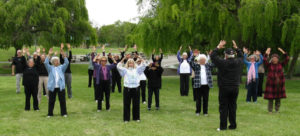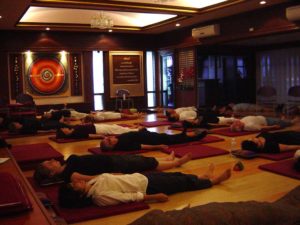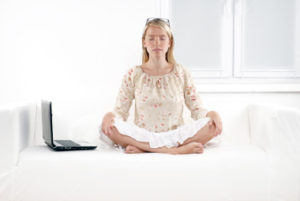Improve Health Anxiety with Online Acceptance and Commitment Therapy
By John M. de Castro, Ph.D.
“Most of us care about our health but for up to 5% of people, worrying about health has become a significant problem in itself. Severe health anxiety, or hypochondriasis, is said to exist when someone holds a strong fear of having a serious disease, despite all medical assurances to the contrary.” – Fabio Fuchelli
Anxiety disorders are the most common mental illness in the United States, affecting 40 million adults, or 18% of the population. A characterizing feature of anxiety disorders is that the suffer overly identifies with and personalizes their thoughts. The sufferer has recurring thoughts, such as impending disaster, that they may realize are unreasonable, but are unable to shake. Health anxiety is a fear of a serious illness can interfere with their daily life. It often leads to seeking unnecessary testing and to spend days consumed by worry. Health anxiety is a relatively common condition, affecting 4% to 5% of both men and women equally.
Anxiety disorders have generally been treated with drugs. But there are considerable side effects and these drugs are often abused. There are a number of psychological therapies for anxiety. But, about 45% of the patients treated do not respond to the therapy. So, there is a need to develop alternative treatments. Recently, it has been found that mindfulness training can be effective for anxiety disorders.
A therapeutic technique that contains mindfulness training is Acceptance and Commitment Therapy (ACT). It is a mindfulness-based psychotherapy technique that is employs many of the techniques of Cognitive Behavioral Therapy (CBT) and has also been shown to relieve anxiety. ACT focuses on the individual’s thoughts, feelings, and behavior and how they interact to impact their psychological and physical well-being. It then works to change thinking to alter the interaction and produce greater life satisfaction. ACT employs mindfulness practices to increase awareness and develop an attitude of acceptance and compassion in the presence of painful thoughts and feelings. Additionally, ACT helps people strengthen aspects of cognition such as in committing to valued living. ACT teaches individuals to “just notice”, accept and embrace private experiences and focus on behavioral responses that produce more desirable outcomes.
Acceptance and Commitment Therapy (ACT), however, requires a certified trained therapist. This results in costs that many clients can’t afford. In addition, the participants must be available to attend multiple sessions at particular scheduled times that may or may not be compatible with their busy schedules and at locations that may not be convenient. As an alternative, mindfulness-based treatments delivered over the internet have been developed. These have tremendous advantages in decreasing costs, making training schedules much more flexible, and eliminating the need to go repeatedly to specific locations. But the question arises as to the effectiveness of these internet applications in inducing mindfulness and improving psychological health.
In today’s Research News article “Development and Feasibility Testing of Internet-Delivered Acceptance and Commitment Therapy for Severe Health Anxiety: Pilot Study.” (See summary below or view the full text of the study at: https://www.ncbi.nlm.nih.gov/pmc/articles/PMC5938695/ ), Hoffman and colleagues examine the acceptability and effectiveness of an internet-based Acceptance and Commitment Therapy (ACT) module applied to the treatment of Health Anxiety Disorder. They recruited participants who expressed symptoms of Health Anxiety Disorder and delivered 7 once-a-week online modules of ACT including 10-15 pages of textual instructions, videos, and home exercises. The participants were measured before and after treatment and 3 months later for health anxiety, depression, anxiety, health related quality of life, life satisfaction, and psychological flexibility.
They found that 80% of the participants completed the program. The participants found the internet format acceptable and some commented that it produced less anxiety working on this at home instead of a hospital or clinic. They found that after treatment there were significant decreases in health anxiety, depression, and anxiety and significant increases in life satisfaction and psychological flexibility. These effects were maintained at the 3-month follow-up. Hence the internet-based Acceptance and Commitment Therapy (ACT) was acceptable to patients and produced lasting benefits in reducing health anxiety and improving psychological health.
This study did not have a comparable control condition and as such has to be seen as a pilot feasibility study. A randomized clinical trial is needed to verify the results. But the present findings are encouraging and suggest that a large controlled study is warranted. The development of an effective online version of ACT would be particularly significant as it would markedly open up accessibility of this therapy to a much wider patient population, reduce costs, and improve outcomes.
So, improve health anxiety with online Acceptance and Commitment Therapy.
“mindfulness allows us to interrupt automatic, reflexive fight, flight, or freeze reactions—reactions that can lead to anxiety, fear, foreboding, and worry.” – Bob Stahl
CMCS – Center for Mindfulness and Contemplative Studies
This and other Contemplative Studies posts are also available on Google+ https://plus.google.com/106784388191201299496/posts and on Twitter @MindfulResearch
Study Summary
Hoffmann, D., Rask, C. U., Hedman-Lagerlöf, E., Ljótsson, B., & Frostholm, L. (2018). Development and Feasibility Testing of Internet-Delivered Acceptance and Commitment Therapy for Severe Health Anxiety: Pilot Study. JMIR mental health, 5(2), e28. doi:10.2196/mental.9198
Abstract
Background
Severe health anxiety (hypochondriasis), or illness anxiety disorder according to the Diagnostic and Statistical Manual of Mental Disorders, 5th edition, is characterized by preoccupation with fear of suffering from a serious illness in spite of medical reassurance. It is a debilitating, prevalent disorder associated with increased health care utilization. Still, there is a lack of easily accessible specialized treatment for severe health anxiety.
Objective
The aims of this paper were to (1) describe the development and setup of a new internet-delivered acceptance and commitment therapy (iACT) program for patients with severe health anxiety using self-referral and a video-based assessment; and (2) examine the feasibility and potential clinical efficacy of iACT for severe health anxiety.
Methods
Self-referred patients (N=15) with severe health anxiety were diagnostically assessed by a video-based interview. They received 7 sessions of clinician-supported iACT comprising self-help texts, video clips, audio files, and worksheets over 12 weeks. Self-report questionnaires were obtained at baseline, post-treatment, and at 3-month follow-up. The primary outcome was Whiteley-7 Index (WI-7) measuring health anxiety severity. Depressive symptoms, health-related quality of life (HRQoL), life satisfaction, and psychological flexibility were also assessed. A within-group design was employed. Means, standard deviations, and effect sizes using the standardized response mean (SRM) were estimated. Post-treatment interviews were conducted to evaluate the patient experience of the usability and acceptability of the treatment setup and program.
Results
The self-referral and video-based assessments were well received. Most patients (12/15, 80%) completed the treatment, and only 1 (1/15, 7%) dropped out. Post-treatment (14/15, 93%) and 3-month follow-up (12/15, 80%) data were available for almost all patients. Paired t tests showed significant improvements on all outcome measures both at post-treatment and 3-month follow-up, except on one physical component subscale of HRQoL. Health anxiety symptoms decreased with 33.9 points at 3-month follow-up (95% CI 13.6-54.3, t11= 3.66, P=.004) with a large within-group effect size of 1.06 as measured by the SRM.
Conclusions
Treatment adherence and potential efficacy suggest that iACT may be a feasible treatment for health anxiety. The uncontrolled design and small sample size of the study limited the robustness of the findings. Therefore, the findings should be replicated in a randomized controlled trial. Potentially, iACT may increase availability and accessibility of specialized treatment for health anxiety.
https://www.ncbi.nlm.nih.gov/pmc/articles/PMC5938695/









